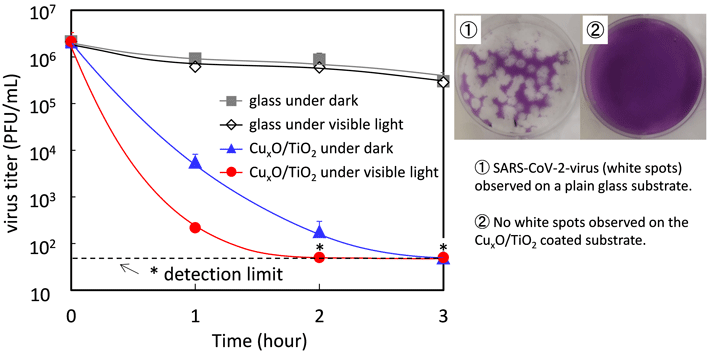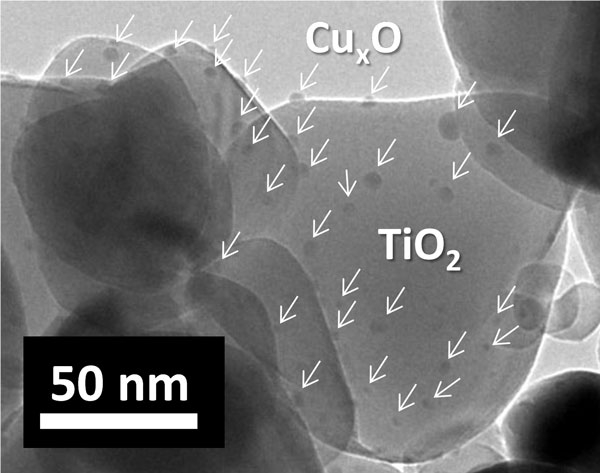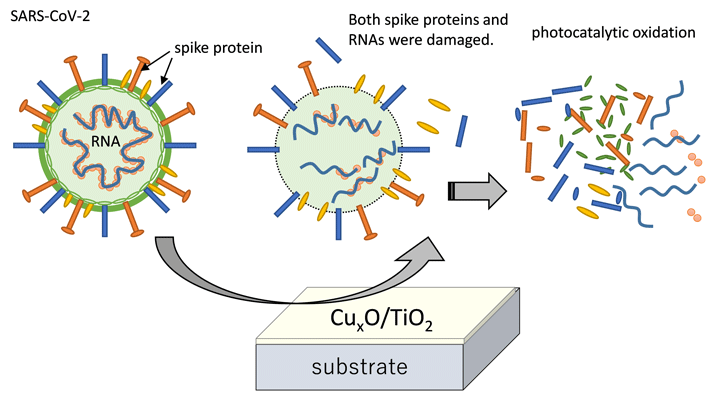Photocatalyst made using a combination of titanium dioxide (TiO2) and copper oxide (CuxO) nanoclusters inactivates various variant types of novel coronavirus SARS-CoV-2. Scientists in Tokyo Institute of Technology, Nara Medical University and Kanagawa Institute of Industrial Science and Technology have developed this antiviral photocatalyst, in a recent breakthrough, which has been proven to be effective under both darkness and indoor light.
The novel coronavirus (SARS-CoV-2), responsible for the ongoing COVID-19 pandemic, has affected millions of people worldwide. The main transmission pathway of the virus is through droplets released by infected people into the air. Additionally, these droplets exist on various surfaces as well. Viral infections mainly occur in indoor environments where many people gather, Antiviral chemicals, such as alcohol and hydrogen peroxide, are often used to decontaminate regularly touched surfaces. These chemicals essentially render the virus inactive by breaking down their proteins. However, these chemicals are volatile in nature and, therefore evaporate away. As a result, the disinfection process has to be carried out regularly.
Now in a study published in Scientific Reports, a research team led by Professor Masahiro Miyauchi, one of the corresponding authors, in Tokyo Institute of Technology, Nara Medical University, Kanagawa Institute of Industrial Science and Technology has developed a solid-state photocatalyst as an alternative defense against the virus. Unlike chemical disinfectants, solid-state coatings remain for a long time, and since the viral outbreak, have been the subject of intensive research around the world. Solid-state antiviral coatings have the advantage of being non-toxic, abundant, and chemically and thermally stable.
Many of these solid-state coatings use TiO2 photocatalysts that, when exposed to ultraviolet (UV) light, cause oxidation reaction that can destroy organic matter like the spike proteins found on the surfaces of coronaviruses. However, these coatings are activated only when exposed to UV light, which is not present in typical indoor environments. In most of indoor environments, lightings are usually turned off in the night time, thus the antiviral material under dark condition is desired.
To get the coating to work under visible light as well dark conditions, the team has developed a composite consisting of TiO2 and CuxO nanoclusters (Figure 2). CuxO nanoclusters are composed of a mixed valence number oxide, in which Cu(I) and Cu(II) species are present. The Cu(II) species in CuxO contributes to the visible-light-driven photocatalysis reaction, whereas the Cu(I) species plays a crucial role in denaturing virus proteins, thereby causing their inactivation under dark conditions.
By coating the CuxO/TiO2 powder on a glass, the team showed that it could inactivate even the highly virulent Delta variant of SARS-CoV-2 as shown in Figure 1. The team has also confirmed the inactivation of Alfa, Beta, and Gamma variants by CuxO/TiO2 in addition to the wild type strain.
The team carefully investigated the antiviral mechanism using sodium dodecyl sulfate-polyacrylamide gel electrophoresis (SDS-PAGE), ELISA assay, and RT-qPCR analysis. These analyses strongly suggest that the Cu(I) species in CuxO denaturalises spike proteins and also causes RNA fragmentation of SARS-CoV-2, even under dark condition (Figure 3). Furthermore, white light irradiation causes the photocatalytic oxidation of the organic molecules of SARS-CoV-2. Based on this antiviral mechanism, the present antiviral material is not limited to a specific variant of the virus and will be effective to inactivate various types of a potential mutant strain.
White light illumination in the present study is usually used as an indoor light apparatus. This can make the CuxO/TiO2 photocatalyst very effective in reducing the risk of COVID-19 infection in indoor environments, which are usually subjected to both light and darkness periodically.
Hopefully, this study will take us one step closer to protecting ourselves better against the coronavirus, and adjusting to the post-COVID era.
. Any information published on this site will be valid in relation to Science Tokyo.






